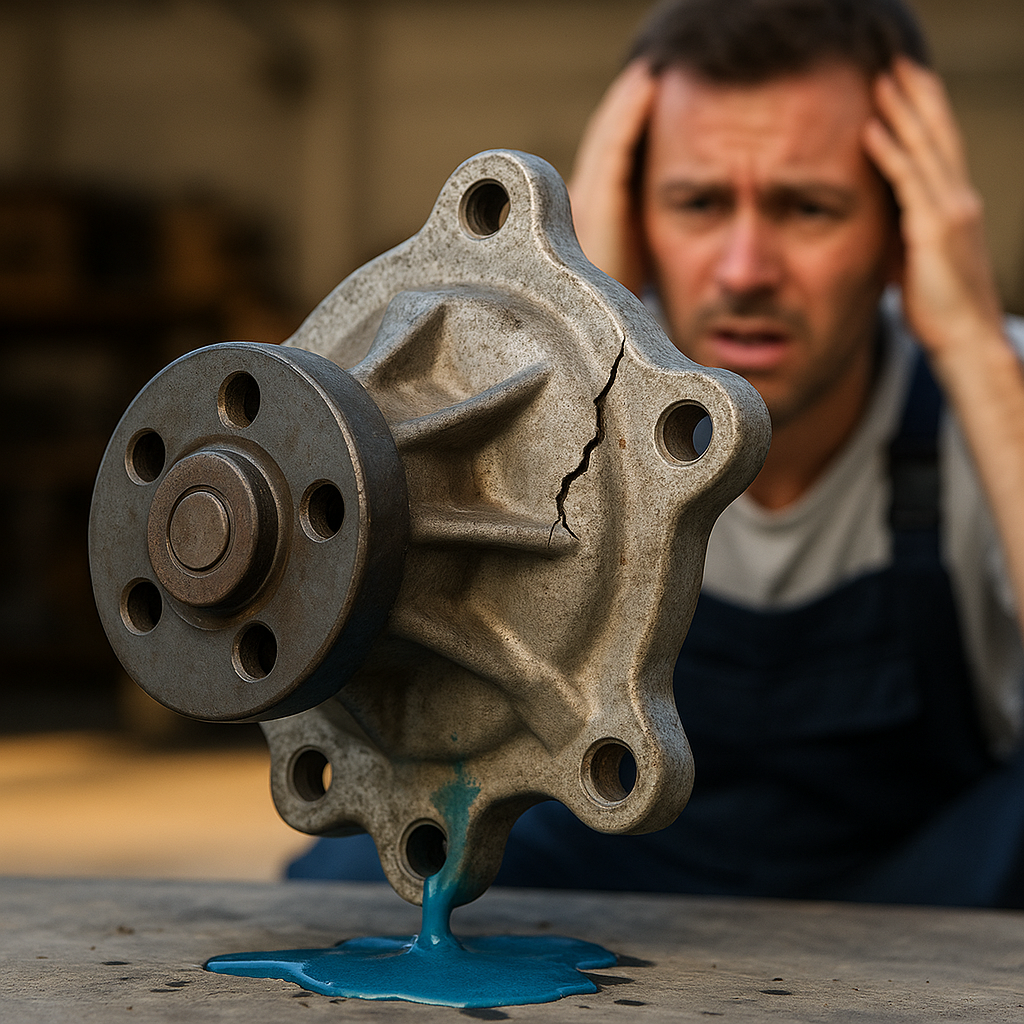💦 Water Pump Failures Suck. No Sugar Coating It.
They’re often buried deep in the engine bay, hiding behind other components like they’re playing hard to get. Replacing one can feel like open-heart surgery with greasy hands. But don’t worry—we’ve got your back.
Below you’ll find a collection of FAQs designed to help you diagnose, understand, and avoid common water pump dramas. Follow the right procedures, and your water pump and your engine can live happily ever after (or at least for a very long time).
🛠️ Water Pump Troubleshooting – FAQs
Q1: Why is my water pump leaking coolant from the weep hole?
A: Coolant leaks are often caused by damage to the mechanical seal inside the pump. Common reasons include:
- Reusing old or contaminated coolant
- Not flushing the engine during coolant replacement
- Using non-standard or low-concentration coolant
- Running the pump without coolant (dry running)
Prevention Tips:
- Always flush the cooling system before installing a new pump
- Use fresh, manufacturer-approved coolant
- Avoid dry starts—ensure the cooling system is properly filled and bled
Q2: What causes the water pump mechanical seal rubber to melt?
A: Melted rubber inside the mechanical seal usually indicates overheating, often due to:
- Insufficient coolant or dry running
- Air pockets in the cooling system
- Using low-quality or reused coolant
How to Avoid It:
- Fill the cooling system to the correct level and bleed the air
- Never reuse coolant
- Only use coolant with the correct concentration and composition
Q3: Why is my water pump making strange noises?
A: There are several types of abnormal noises and causes:
- Bearing Noise: Often caused by dropping the pump or excessive belt tension
- Seal Noise: Dry running or diluted coolant can damage seal surfaces
- Belt Noise: Usually due to a worn or loose belt slipping on the pulley
Solution:
- Handle the pump carefully during installation
- Set the belt to the manufacturer’s specified tension
- Replace old belts and components as needed
Q4: Can dropping a water pump cause damage?
A: Yes. Even a minor drop can dent the bearings, leading to abnormal noise, increased vibration, or premature failure.
Tip: Always handle the pump with care and never strike the pulley or flange with tools.
Q5: What is cavitation and how does it damage my water pump?
A: Cavitation occurs when vapor bubbles form and collapse inside the coolant flow. Common causes include:
- Deteriorated or reused coolant
- Improper coolant levels or air in the system
- Over-revving the engine
- Using the wrong coolant type
Damage caused: Pitting or holes in the impeller or pump housing, overheating, and eventual failure.
Preventative Steps:
- Use fresh, high-quality coolant
- Bleed the cooling system properly
- Avoid aftermarket modifications that alter coolant pressure or flow
Q6: Why is the water pump case or housing cracked?
A: Cracks can be caused by:
- Excessive torque during installation
- Physical shock or dropping the unit
- Internal pressure surges from overheating or cavitation
- Casting defects in the pump housing
How to Prevent:
- Follow proper torque specs during installation
- Avoid dropping or mishandling the pump
- Maintain cooling system health with proper coolant and pressure control
Q7: Should I reuse my old coolant, pulley, or bolts?
A: No. Reusing these components increases the risk of failure due to:
- Contaminated or degraded coolant causing seal and impeller damage
- Worn pulleys causing misalignment
- Bolts losing clamping strength
Recommendation: Always use new coolant, pulleys, and bolts when replacing the water pump.
Q8: Can using a liquid gasket cause problems?
A: Yes—especially if your water pump uses an O-ring or pre-installed gasket. Liquid gasket can:
- Contaminate the coolant
- Interfere with proper sealing
- Lead to leaks and reduced performance
Rule of Thumb: Never use liquid gasket with O-ring-equipped pumps unless explicitly recommended.
